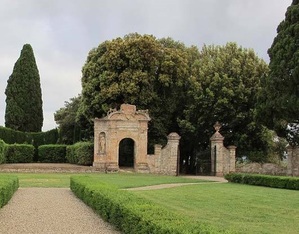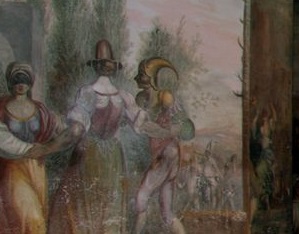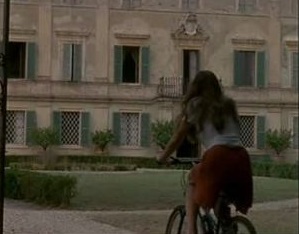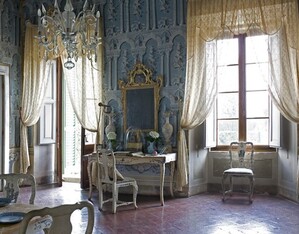Surrounded by fine vineyards and olive groves, this garden in the Chianti hills hosts one of Italy’s most interesting open-air theatres, used today as in the past to stage plays, in which the architecture harmoniously blends with the plant elements.
In the 1530s, the turreted farmhouse here belonged to the Bandinelli family. It was enlarged and repurposed between 1768 and 1799, to mark Anton Domenico’s second marriage to Cecilia Chigi Zondanari. Closely related to the villa’s architecture, the garden layout dates back to that period. Enclosed at the back by the open-air theatre, the so-called piazzone is the most original element of the entire composition. Lined up with the building, it was built prior to 1783, the year when Vittorio Alfieri staged one of his tragedies here (the room where the poet stayed is furnished with a sumptuous canopied bed). The small theatre’s stage space is outlined by a ring-shaped set of double laurel hedges. The entrance is marked by two brick aedicule-propylaia which are topped with the Bianchi Bandinelli and Chigi Zondanari families’ coats of arms. Statues of Comedyand Tragedystand in their own niches. As at nearby Villa Gori, a tall cypress tree accentuates the perspective effect of the stage. An axis orthogonal to the one that connects the building and theatre leads to the “wild garden” on one side, and a formally-designed vegetable garden on the other, which features an elegant semicircular fishpond. A boundary wall decorated with terracotta sculptures surrounds the entire green area. Six monumental gates, also decorated with terracotta sculptures, offer access through the wall.
Highlights

The Holm Oak “Trellis”
In a landscape solution of great originality and beauty, the property is accessed through an extraordinary “trellis”, a tunnel of centuries-old holm oaks which is broken up by a circular space bordered by high topiary hedges.

The Villa’s Frescoes
In the late 18th century, Tyrolean painter Ignazio Moder theatrically illustrated a variety of aspects of country life and scenes from the Commedia dell’Arte in the long gallery on the ground floor. Perellino (a singer/musician mentioned by Vittorio Alfieri) is also portrayed there, as are his actress daughters.

Film Set
In 1995, Bernardo Bertolucci chose the villa as a location for a number of scenes in his film “Stealing Beauty”, in which the harmony of the Siena countryside is shattered by conflicts among the lead characters, who end up defeated by their experience of living out their rural idyll.

Theatre References
A number of references to the theatrical world feature in the villa’s furnishings and decor. Aedicule-propylaia, the symbol of the open-air theatre around which the villa is built, are reproduced on a number of chairs. The enclosing wall is characterized by a series of statues of putti and monkeys, animals traditionally used in theatrical representations; these are also repeated in the proscenium of the Garzoni di Collodi garden.
 Villa di Geggiano
Contacts
Villa di Geggiano
Contacts
Contacts
Telephone:0577 356 879
Address
Località Geggiano 1
53019, Castelnuovo Berardenga (SI)
 Villa di Geggiano
Opening times and prices
Villa di Geggiano
Opening times and prices
Opening hours
The Villa can be visited only by booking. For further information fill in the form of the site
Pricing
There is a charge for the visit and booking is required.
 Villa di Geggiano
How to get there
Villa di Geggiano
How to get there
Address
Località Geggiano 1
53019, Castelnuovo Berardenga (SI)
Latitude: 43.2128
Longitude: 11.2256
How to arrive by road
From Florence:
- From the A1 Milano-Roma motorway, take the Firenze Impruneta exit and follow the signs for Siena, drive about 56 km on the Firenze – Siena highway, exit at Siena Nord. At the roundabout take the second exit following the signs for Siena Centro and Stazione Ferroviaria. At the next roundabout take the first exit towards the station and continue towards Arezzo. Continue in the direction of Montevarchi (SP 408), Pontignano and Gaiole in Chianti. Continue towards Ponte a Bozzone. Turn left after about 1 km on a dirt road Via Alessandra Mari. The road is lined with cypress trees and leads to the gates of the Villa, the parking lot is on the left.
From Rome
- Motorway A1 Roma-Firenze, exit Valdichiana. After the tollbooth turn right and continue for about half a kilometer until the second junction, always follow the blue signs for Siena. Continue for about 50 km and exit at Siena Est, at the roundabout follow the signs for Siena. Continue in the direction of Siena Centre. At the next roundabout take the third exit towards Montevarchi (SP 408), Pontignano and Gaiole in Chianti. Continue towards Ponte a Bozzone, turn left after about 1 km on a dirt road Via Alessandra Mari. The road is lined with cypress trees and leads to the gates of the Villa, the parking lot is on the left.
 Villa di Geggiano
Services/Accessibility
Villa di Geggiano
Services/Accessibility
Services
Inside the Villa it is possible to buy organic wine and oil of own production.
The Villa di Geggiano allows you to visit its rooms and to taste and savor the wines of Chianti. Visits are organized exclusively by reservation in groups of eight or more participants.
- Guided tours of the Villa, winery and gardens: € 15,00 (+ VAT) per person
- Guided tours of the Villa, cellar and gardens and wine tasting: € 30,00 (+ VAT) per person.
The Villa di Geggiano offers its guests the possibility of staying in the newly restored garden pavilion. The pavilion offers new and modern facilities with contemporary furnishings. For more information about costs and types of accommodation, please consult the website of the Villa.
 Villa di Geggiano
Private events
Villa di Geggiano
Private events
The Villa di Geggiano makes its facilities available for various occasions and numerous private events such as weddings, gala dinners and conferences, with the possibility of choosing the various menus offered by the Villa’s catering service. The Villa also offers its spaces for television and film shoots, advertising and photo shoots. For further information please fill in the form of the website.
 Villa di Geggiano
Itineraries
Villa di Geggiano
Itineraries
You could find the garden in these itineraries
 Favorite saving result
Favorite saving result
 Warning!
Warning!
You've have to sign up or sign in to add this element to your favorites.
